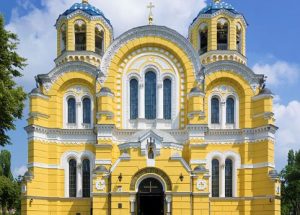The Geopolitics of Ukraine’s Newly Independent Church
By Emil Avdaliani

St Volodymyr's Cathedral in Kiev, Ukraine, photo by Petar Milošević via Wikipedia
BESA Center Perspectives Paper No. 1,033, December 11, 2018
EXECUTIVE SUMMARY: The Russian Orthodox Church (ROC) is experiencing troubles in Ukraine. Areas once considered to be the uncontested territory of the Russian Patriarchate are now becoming autocephalous (independent), adding yet another dimension to the geopolitical challenges Russia is facing in the borderlands of the former Soviet space.
Russian history over the past several centuries was marked by battles over territories running from the Baltic to the Black Sea in the south, then towards the South Caucasus in the east. These are the lands for which the Russians fought the Swedes, the Poles, the Turks, the armies of Napoleon, the Nazis, and the Iranians. The Russians succeeded in fighting off their geopolitical challengers, stalling European advances into the arc of lands around the Russian heartland where most of its industrial and human potential lay.
When it came to direct military confrontation, the Russians were not fundamentally weaker than their European or Asian rivals in any of these cases. There were, however, deficiencies in the organization of the Russian military machine, alongside a lack of up-to-date military capabilities. Still, those problems were mitigated by Russian geography, a large landmass, and a poor road infrastructure that made the territory difficult to penetrate.
Like its antecedents, the modern Russian military does not fundamentally lag behind its western competitors. The gap has been so small historically that neither Russia nor any of the European powers was ever completely dominant on the continent for any extended period.
It is therefore somewhat baffling to hear that the Russians are afraid of NATO expansion near their borders. It is true that no power is pleased by the prospect of rival armies near its own periphery, and Russia is no exception. But why should NATO expansion near Russian frontier lands differ in effect from previous invasions by European commanders?
The seriousness of the threat posed by NATO troops to Moscow is in fact questionable. NATO troops are already in the Baltic states, and Turkey is a longtime member of the Alliance. Considering modern military technologies and Russia’s ability to defend itself, it is surprising to see how much emphasis Moscow continues to put on military aspects even as critical developments are taking place in the borderlands in the economic and cultural realms – areas where Russia is losing its grip.
For centuries, western economic reach into the Russian borderlands was meager, and Moscow faced only military threats that it was able to repel. In the last twenty to thirty years, however, Western powers have been able to expand their economic reach. The EU has attached former Soviet protectorates in eastern Europe as well as all three Baltic states. Moreover, the EU is active in Ukraine, Moldova, and the South Caucasus – so much so that much of these countries’ trade is now associated with the West.
Beyond economics, the geopolitical landscape is tilting towards the West on the local level. Elites in Ukraine and Georgia are being redirected towards the West through economic and political incentives. Youngsters, when choosing among study abroad options, predominantly head to western universities. Upon their return to their native countries, they often go on to occupy key governmental positions.
In the spiritual realm, the Russian Orthodox Church has been predominant for centuries, claiming its right to unite Orthodox Christians over large expanses of the Eurasian landmass. Today, however, it is experiencing troubles in Ukraine. The Ukrainian Orthodox Church was canonically under the ROC’s jurisdiction, but ever since the Ukraine conflict in 2014, Kiev has distanced itself from the Russian Church. Ukrainians claim that the transfer of the Kyivan Metropolitan See in the late 17th century to Moscow was unlawful.
A meeting held on August 31 between Russian Patriarch Kirill and Ecumenical Patriarch Bartholomew signaled that the Ukrainian Church was to gain its autocephaly (independence). Sure enough, steps taken in September and October by the Constantinople patriarchate led to recognition of the independence of the Ukrainian Orthodox Church, a move immediately hailed by Ukrainian President Petro Poroshenko but slammed by Moscow as “catastrophic.”
Religion might not be a decisive factor in the battle for the borderlands between Russian and the West, but it is nevertheless important in that it cuts the Ukrainians off culturally from the “Russian world.” The autocephalous movement in Ukraine has been intertwined with the country’s other attempts to increase its geopolitical independence from Moscow. This time, the attempt brought results, serving as yet another indicator of the extent to which Russian influence may be diminishing in its immediate neighborhood.
View PDF
Emil Avdaliani teaches history and international relations at Tbilisi State University and Ilia State University. He has worked for various international consulting companies and currently publishes articles on military and political developments across the former Soviet space.
BESA Center Perspectives Papers are published through the generosity of the Greg Rosshandler Family
www.fotavgeia.blogspot.com

Δεν υπάρχουν σχόλια:
Δημοσίευση σχολίου